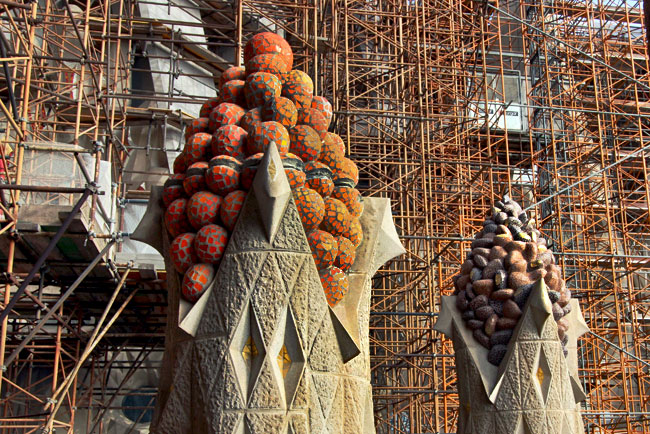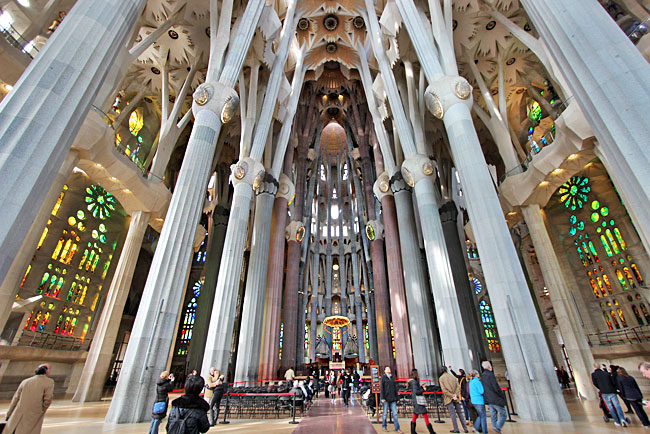Like most visitors to Barcelona, Spain, the UNESCO World Heritage Site of Sagrada Familia Basilica was on my must-see list, so I was surprised when an employee of the hotel where I was staying told me not to bother going inside. “Tickets are very expensive and there’s not much to see,” he said. If I hadn’t been convinced by his advice, the block-long line of people waiting to buy tickets sealed my decision; seeing the outside was sufficient. Two months later I returned to Barcelona during the off-season. The long lines were gone and I simply couldn’t resist seeing the famous Sagrada Familia interior.
At the passion facade I paused to examine the twin bronze doors that display snippets of verse from the New Testament, noting the differing heights of the raised letters, as if the artist wanted some words to stand out more than others. In the dim light, I made my way to the center of the nave and stood at the intersection of the Latin Cross floor plan. Soft light streamed through stained glass windows that wrapped the nave, bathing everything in rich shades of purple, green, gold, and pink. I craned my neck, tracing massive tree-trunk columns to the vaulted ceiling, where a canopy of stone leaves spread, as if protecting parishioners from the elements. A tingle ran up my spine as I soaked in the atmosphere of serenity and prayer. It felt as if I was looking at the church through the eyes of Antoni Gaudí, the famous Catalán architect responsible for the structure we see today.
When Gaudí died in 1926, Sagrada Familia was barely 25% complete but a few months before he was killed in a tragic trolley accident he was able to see the pinnacle of the St. Barnabas bell tower placed atop the Nativity facade. He looked at the colorful Venetian mosaics with which the pinnacle was decorated and declared, “Look at the top! Is it not true that it seems to unite Heaven and Earth? This burst of mosaics is the first thing that sailors will see when approaching Barcelona; it will be a radiant welcome.” By that time, the Catalán architect been working on the famous Barcelona church for 43 years and it barely resembled the Gothic revival design proposed by its original architect, Francisco de Paula del Villar. Only the crypt of the church was completed before Villar retired, one year after beginning construction. Gaudí took over and completely reinterpreted the style of the church.
Can’t view the above slideshow? Click here.
Originally, Gaudí opted for a Neo-Gothic approach but over the ensuing years he began tinkering with new design ideas. As a youngster, he had suffered from bouts of rheumatism that delayed his schooling and kept him from playing with other children. Instead, his mother took him on long nature walks in the countryside. In his waning years, Gaudí credited these walks as having allowed him to capture “the purest and most pleasant images of nature, that nature that is ever our Mistress.” It was that Mistress to whom he turned for guidance in the design of Sagrada Familia. Using a magnolia leaf as inspiration, he experimented with parabolic design, a method of building curves from straight lines, testing his theories in the construction of a small cottage to be used as a school for the children of construction workers.

By 1915 he had begun to study the geometry of hyperboloids and once again, nature was his muse. He envisioned the interior columns in the nave and aisles of the church as enormous trees that created an overarching canopy of leaves, though which the sunlight could be seen in daytime and the stars in the heavens at night. After many years of research into the helicoidal growth of plants, Gaudí adopted this movement of growth for the design of his columns, using Oleander branches as a model. For exterior elements, Gaudí studied the crystallization of minerals like pyrite, fluorite and galena. He incorporated these polyhedral forms into giant fruit cones, colored with Venetian ceramics, that crown the Basilica towers.

Even now, 77 years after the architect’s death, neither the exterior nor the Sagrada Familia interior is complete. Some claim it will be complete by 2026, some say even earlier, but signage at the church now claims the facility will be completed by the middle of this century. What is clear is that work continues at a lively pace. Three lemon-colored construction cranes towered over the church, laying stone elements in place, while workmen crawled around scaffolding that covered the yet to be completed Glory Facade. During his lifetime Antoni Gaudí insisted that, “The great book, always open and which we should make an effort to read, is that of nature.” But you can’t read the book of the Sagrada Familia unless you pay the 13.50 Euros (~$17.50 USD) to actually see the Sagrada Familia interior. In my opinion it’s well worth the price of admission. I left that evening feeling as if I’d read volumes.


2019 Mar 17th
My wife and I were speel bound by the scale of this wonderful work of Art.
We spent several hrs there and took many photos. The power of this structor was over the top. Thank you for your wonderful photos, Braught back many old memories.
Beautiful pictures! It’s a good thing you ignored the gentleman who told you it wasn’t worth it! Next time, buy your tickets online and go straight to the front of the line. No waiting!
Agreed Sue! And thanks for the tip.
So incredible beautiful! We spent 3 weeks in Europe recently but unfortunately we were not able to visit Spain, it is definitely on our agenda for our next visit. Your photos are amazing, that’s for sharing!
It is incredibly beautiful, Barbara, and to think I almost didn’t go inside! Hope you get to Spain at some point; it’s one of my favorite countries.
I was there three years ago, but didn’t go inside… Now I see that I missed a lot.. It is so beautiful 🙁
Hi Divine: Since it will not be finished until the middle of this century, you have lots of time to go back and see it next time around 🙂
beautiful! i’d love to see it.
You’d love it Jesse – truly a marvel.
I last visited Barcelona in 2008 when our son finished a semester studying there and La Sagrada Familia was a “must see” for us, including the inside. I can see from your photos that much has been added to the inside since we were there — an excellent excuse for another trip. My husband tends to have a “been there, done that” approach to travel that I don’t share. Your photos tell me that my desire to visit Barcelona again is well founded.
Hi Suzanne: I’ve heard this from others. Seems that construction moves at a pretty fast pace. I’d say that it would look quite different from one year to the next, and, at the very least, it’s an excuse to go back to Barcelona.
Your concierge reminds me of mine in Norway, who said, “There’s not much to see if you take that route. Well, there are fjords and stuff.”
I lived here almost 20 years ago, when there really wasn’t an interior yet. Thank you for updating and completely enhancing my mental reference.
LOL Jenna. After I saw the interior, I was astounded that anyne could even suggest, much less believe, that the inside wasn’t worth the price of admission.
Andy and I didn’t go inside when we were there last August because we got there too late in the day, but I’d love to go inside at some point whenever we return to Barcelona. Sounds really interesting, and your pictures are gorgeous!
Oh Ali, go if you have an opportunity. It’s just breathtaking and the entrance fees are used to keep the construction going.
It’s by far the most magnificent ceiling I’ve ever seen 🙂
The whole place is just astonishing, Loz!
This is one awesome post! The first and second photos have amazing perspectives on them but wow! That first picture also has some very vibrant colors. Seems like I could touch them from here! Great blog!
What an extraordinary building. I have been to Barcelona and cant believe I missed it, worth going back for I think
Gaudi is the best. We toured BCN last year and fell in live with these masterpieces.
I didn’t get inside Sagrada Familia during my short stay in Barcelona in September — just not enough time for everything. But I’ll make it a point to do so next time (hopefully, off season). Beautiful photos, Barbara. Certainly much more to see there than the hotel employee let on.
That’s for sure Cathy! So glad I ignored his advice. And judging by what others have said here, by the time I return to Barcelona, I’ll need a return visit.
This fantastic church should be seen by everyone, believer or not. So much has been accomplished since my husband and I were there in 2012. Thank you for the beautiful pictures that show how much it’s changed. The stained glass windows were an unexpected treat discovered in your photographs.
Libbie
Glad you enjoyed the photos, Libbie. I can just imagine how fast the place changes, given all the work going on. It was really interesting to stand in the middle. Looking toward the altar, all the stained glass windows are casting gorgeous colors over everything, while in the other direction, white light streams in through windows not yet installed.
Beautiful. My house used to be two blocks away and the Sagrada Familia was the view from my bedroom window. I loved to watch it being built. It has changed a lot, inside and out.
Wow Cristina – that must have been a fabulous view!
Barbara, your photos are always so beautiful!
So glad you went back and went inside!
Thank you Patty! I’m really glad I finally ignored that bad advice, too.
That is crazy telling people to not go inside. I was there three years ago and it the inside was not finished but it was still worth it. I love walking down the towers and seeing the different views from above. I can not wait to go back.
I know, Jeff! After seeing the inside I couldn’t believe anyone would say it wasn’t worth the price of admission. Thank goodness I didn’t listen.
I think nearly all cathedrals have taken 100s of years to build so this one is going pretty quickly on historic cathedral building standards!!
Good point, Mark – never really thought of it that way.
It is a long time since I was in Barcelona, when I visited Sacrada Familia, so I expect quite a bit more has been built. I love the photos looking up at all that wonderful stone carving.
Heather, someone else said the photo looking up at the canopy was beautiful, but dizzying. He was so right 🙂
oh no…I think the inside is the best bit! When I went in August, it was my friend who said ‘we have to go’ and I’m so glad I did. I just couldn’t stop saying ‘wow’ once I walked uner the Passion facade and through those doors.
I hear you Kym, and couldn’t agree more. I spent the entire day there, right up to closing time, and could have stayed hours longer.